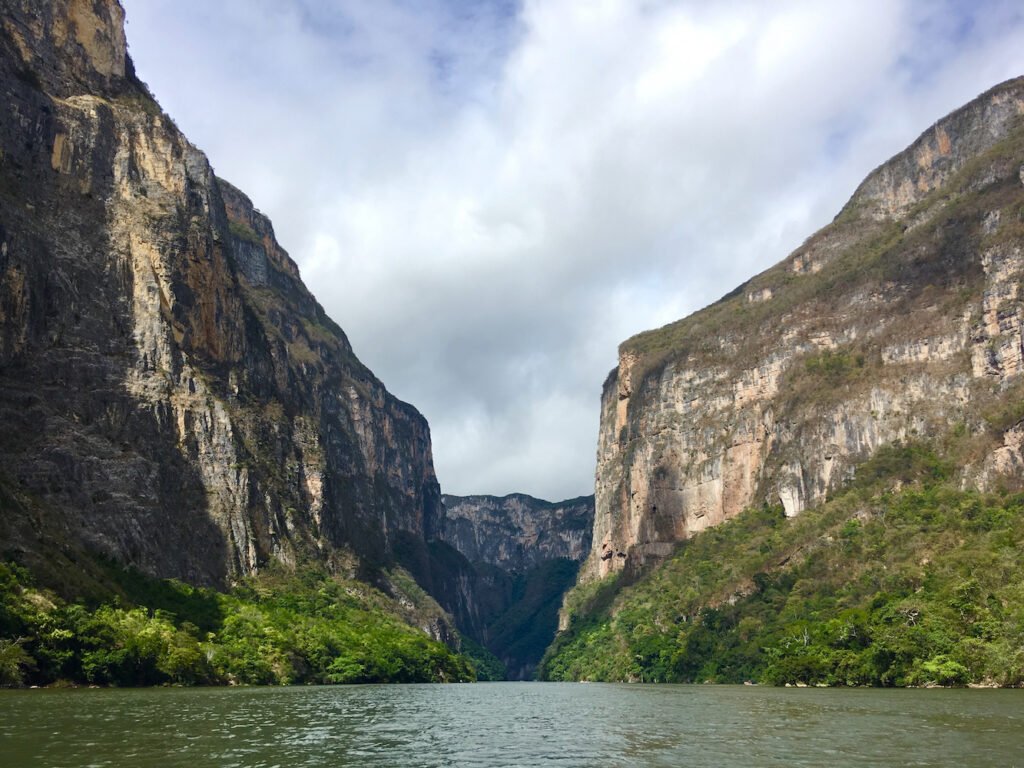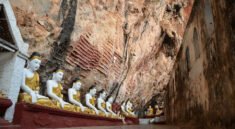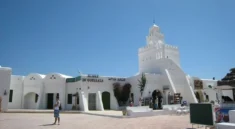
Deep in the heart of Chiapas, Mexico’s southernmost state, lies a geological marvel shaped by millennia of natural forces—a place where towering cliffs, lush jungle, and pristine river waters come together to create one of the country’s most awe-inspiring and least-explored natural wonders. This is the hidden canyon of Chiapas, a majestic formation carved by the powerful Grijalva River, where nature thrives in solitude and adventure beckons those willing to stray off the beaten path.
This canyon, often overshadowed by more famous sites like Palenque or Sumidero Canyon, remains a best-kept secret—even among seasoned travelers. Accessible only through local guides or small boat expeditions, it offers an immersive journey into the wild, where sheer rock walls soar hundreds of meters into the sky, tropical foliage clings to every ledge, and the rhythmic sounds of birds, monkeys, and rushing water become the soundtrack to your exploration.
A Mysterious Beginning: The Path to Discovery
The journey to the hidden canyon begins in Tuxtla Gutiérrez or San Cristóbal de las Casas, two of Chiapas’ most well-connected cities. From here, visitors must travel through rural villages, winding mountain roads, and dense forest paths before reaching the edge of the Grijalva River. The transition is dramatic: bustling markets and colonial squares fade into untouched wilderness, where civilization seems to disappear and nature takes over.
The last leg of the journey is typically made by lancha—a long, flat-bottomed boat guided by locals who know the river like the lines on their palms. As the boat moves upstream, the riverbanks grow wilder. Trees dip their branches into the water, herons stand motionless in the shallows, and crocodiles sunbathe lazily along the muddy banks. Then, like a curtain being drawn open, the canyon reveals itself.
Massive limestone cliffs, some reaching over 1,000 meters in height, rise almost vertically from the river. The canyon narrows, the light dims, and a palpable silence descends—interrupted only by the calls of howler monkeys echoing across the walls. It’s not just a place—it’s an experience that humbles and exhilarates.
The Heart of the Canyon: Raw Beauty on a Monumental Scale
The canyon stretches for several kilometers, each turn offering a new perspective on the scale and power of nature. The walls are lined with moss, orchids, and bromeliads, thriving on the cliffs where rain and mist create microclimates. Waterfalls cascade from hidden crevices high above, some crashing into the river below with thundering force, others gently feeding streams that trickle through ferns and vines.
One of the most mesmerizing features is the “Arbol de Navidad” or Christmas Tree Waterfall, where mineral-rich water flows over a rock face shaped like a massive fir tree. The waterfall glistens with green and golden hues, shimmering in the sunlight like tinsel.
Above, birds of prey—such as hawks and vultures—circle effortlessly, riding thermal currents. Kingfishers and egrets dart across the water, while the occasional river otter may be seen gliding through the shallows. Spider monkeys and coatis watch from the canopy, curious but cautious of human visitors. In this protected ecosystem, biodiversity thrives, creating a living tapestry of flora and fauna that feels untouched by time.
A Living Sanctuary: The Ecological Importance
Beyond its visual grandeur, the hidden canyon is a critical ecological reserve. It supports endemic and endangered species, including jaguars, ocelots, and rare birds like the quetzal and rufous-tailed hummingbird. The tropical deciduous forest that blankets the canyon’s upper edges is among the most biologically diverse regions in Mesoamerica.
Conservation efforts by local communities and environmental organizations have helped keep this ecosystem intact. Visitors are often educated on eco-tourism principles, including waste minimization, staying on designated trails, and avoiding noise pollution. Some parts of the canyon are off-limits to protect fragile breeding grounds and migratory habitats.
By choosing to visit this canyon respectfully and sustainably, travelers become stewards of its preservation, contributing to its long-term protection.
Adventure Awaits: Hiking, Kayaking, and Cave Exploration
While a boat ride offers the most accessible way to explore the canyon, adventurous travelers can hike its upper ridges for sweeping views of the cliffs and river below. Trails, though rugged and sometimes overgrown, lead to lookout points where the full grandeur of the canyon can be appreciated. From these heights, the river appears like a winding serpent of silver, and the jungle stretches endlessly to the horizon.
For a more hands-on experience, kayaking is available through guided expeditions. Gliding silently along the Grijalva allows for closer encounters with wildlife and a sense of harmony with the environment. In some spots, the water narrows, and the towering walls seem to close in around you, creating an almost spiritual atmosphere of isolation and wonder.
Caves and sinkholes, formed by centuries of water erosion, pepper the canyon. Some are large enough to enter, revealing underground chambers filled with stalactites, bat colonies, and subterranean streams. Local legends speak of hidden treasures, sacred Mayan altars, and spirits that inhabit these spaces—adding an air of mystery to your exploration.
Cultural Context: A Canyon with a Past
The region around the canyon is steeped in Mayan and Zoque heritage. Ancient peoples once revered the Grijalva River as a sacred source of life, and petroglyphs carved into rocks near the riverbanks tell stories of fertility, rainfall, and the natural cycles of the Earth. Some believe the canyon served as a spiritual passage, a gateway between the physical and metaphysical worlds.
Today, small indigenous communities still live near the canyon, preserving traditional knowledge, crafts, and rituals. Travelers may be invited to participate in ceremonial dances, herbal healing practices, or to learn about the cosmovision that sees nature not as a resource, but as a living ancestor deserving of respect and reverence.
Visiting these villages is not just a cultural encounter—it’s an opportunity to support community-led tourism that empowers locals while keeping traditions alive.
Unmatched Views: Sunrise and Sunset in the Canyon
Few places on Earth offer the visual drama of the hidden canyon at sunrise and sunset. As dawn breaks, mist rises from the jungle, slowly revealing the canyon’s walls as if nature is lifting a veil. The golden rays of the sun strike the highest cliffs first, then crawl down to the water, igniting the entire canyon in hues of amber, gold, and rose.
At dusk, the experience is reversed. The sky deepens into purple and crimson, bats begin their nightly flight, and the jungle hums with nocturnal life. The river reflects the last light of day like a mirror, and stars begin to appear in the darkening sky. This twilight transformation is a moment of profound beauty—a reminder of nature’s rhythms and the fleeting perfection of the present.
Staying Nearby: Eco-Lodges and River Retreats
Though there are no hotels inside the canyon itself, several eco-lodges and riverside retreats nearby offer comfortable and immersive accommodations. Built with natural materials and sustainable practices, these lodgings emphasize connection with the environment rather than luxury.
You’ll fall asleep to the sounds of the forest, wake to birdsong, and enjoy meals made with locally sourced ingredients—fresh river fish, tropical fruits, and traditional corn-based dishes. Some lodges offer guided tours, birdwatching walks, and community visits, providing a full-circle experience of the canyon and its surroundings.
Best Time To Visit
The best time to explore the canyon is during the dry season from November to April, when the river is calm and trails are accessible. During the rainy season (May to October), the river can rise dramatically, making some areas dangerous or impassable, though the jungle is at its greenest and most vibrant.
It’s recommended to go early in the morning to avoid midday heat and to increase the chances of spotting wildlife.
A Final Reflection: More Than A Destination
The hidden canyon of Chiapas is not just a spectacular sight—it’s an invitation to witness Earth’s grandeur in its purest form. It’s a place where time slows, where human voices hush in reverence, and where every stone, leaf, and ripple in the water seems charged with meaning.
In an age where so many travel experiences are curated, packaged, and filtered through screens, this canyon offers authenticity and raw beauty. There is no cell signal here. No concrete paths. No queues. Just you, the river, the cliffs, and the wild.
To explore this hidden canyon is to reconnect—not only with nature but with yourself. You’ll return from it not just with photos, but with a deeper sense of awe, a renewed appreciation for the planet, and perhaps a silent promise to protect it.




